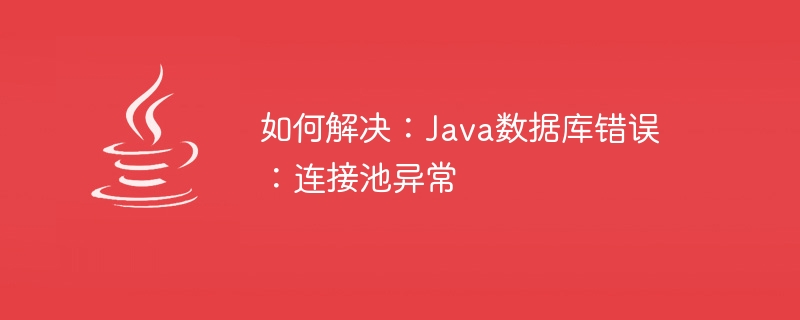

How to solve: Java database error: Connection pool exception
Introduction:
When using Java for database operations, you often encounter the problem of connection pool exception . Connection pooling is a technology designed to improve the efficiency of database operations. It can reuse established database connections and avoid frequent creation and destruction of connections. However, when an exception occurs in the connection pool, the connection cannot be obtained or released, causing database operation problems. This article will introduce some common connection pool exceptions and provide solutions and related code examples.
Connection timeout exception:
Connection timeout exception is mainly due to the connection in the connection pool being occupied for too long and unable to be released, causing all the connections in the connection pool to be full and unable to obtain available connections. . The way to solve this problem is to set the connection timeout in the code and release the connection in time. The following is a sample code using druid connection pool:
import com.alibaba.druid.pool.DruidDataSource;
import java.sql.Connection;
import java.sql.PreparedStatement;
import java.sql.ResultSet;
import java.sql.SQLException;
public class ConnectionPoolExample {
private static DruidDataSource dataSource;
static {
dataSource = new DruidDataSource();
dataSource.setUrl("jdbc:mysql://localhost:3306/test");
dataSource.setUsername("root");
dataSource.setPassword("password");
dataSource.setMaxActive(100);
dataSource.setInitialSize(10);
dataSource.setMinIdle(5);
dataSource.setMaxWait(5000);
}
public static Connection getConnection() throws SQLException {
return dataSource.getConnection();
}
public static void main(String[] args) {
Connection conn = null;
PreparedStatement stmt = null;
ResultSet rs = null;
try {
conn = getConnection();
stmt = conn.prepareStatement("SELECT * FROM user");
rs = stmt.executeQuery();
while (rs.next()) {
System.out.println(rs.getString("username"));
}
} catch (SQLException e) {
e.printStackTrace();
} finally {
try {
if (rs != null) {
rs.close();
}
if (stmt != null) {
stmt.close();
}
if (conn != null) {
conn.close(); // 释放连接
}
} catch (SQLException e) {
e.printStackTrace();
}
}
}
} In the above code, we limit the maximum number of connections in the connection pool by setting setMaxActive and set setMaxWaitTo define the maximum waiting time for the connection. When the connections in the connection pool are full and the waiting time exceeds the set time, a connection timeout exception will be thrown. We release the connection by calling the conn.close() method in the finally block to ensure that the connection can be recycled in time.
Connection leak exception:
Connection leak exception is due to the failure to release the connection correctly in the code, which causes the number of connections in the connection pool to continue to increase, and eventually the resources of the connection pool are exhausted, and no new connections can be created. . The way to solve this problem is to ensure that the connection is closed promptly after each use. The following is a sample code using C3P0 connection pool:
import com.mchange.v2.c3p0.ComboPooledDataSource;
import java.sql.Connection;
import java.sql.PreparedStatement;
import java.sql.ResultSet;
import java.sql.SQLException;
public class ConnectionPoolExample2 {
private static ComboPooledDataSource dataSource;
static {
dataSource = new ComboPooledDataSource();
dataSource.setJdbcUrl("jdbc:mysql://localhost:3306/test");
dataSource.setUser("root");
dataSource.setPassword("password");
dataSource.setMaxPoolSize(100);
dataSource.setInitialPoolSize(10);
dataSource.setMinPoolSize(5);
dataSource.setMaxIdleTime(60);
}
public static Connection getConnection() throws SQLException {
return dataSource.getConnection();
}
public static void main(String[] args) {
Connection conn = null;
PreparedStatement stmt = null;
ResultSet rs = null;
try {
conn = getConnection();
stmt = conn.prepareStatement("SELECT * FROM user");
rs = stmt.executeQuery();
while (rs.next()) {
System.out.println(rs.getString("username"));
}
} catch (SQLException e) {
e.printStackTrace();
} finally {
try {
if (rs != null) {
rs.close();
}
if (stmt != null) {
stmt.close();
}
if (conn != null) {
conn.close(); // 释放连接
}
} catch (SQLException e) {
e.printStackTrace();
}
}
}
}In the above code, we can limit the maximum number of connections in the connection pool by setting setMaxPoolSize, setMaxIdleTimeTo define the maximum idle time of the connection. When the idle time of the connection in the connection pool exceeds the set time, a connection leak exception will be thrown. By calling the conn.close() method in the finally block to release the connection, the connection leak problem can be avoided.
Summary:
Connection pool exceptions are common problems in Java database operations, but by setting a reasonable connection timeout and releasing the connection in a timely manner, and ensuring that the connection can be closed correctly after use, you can Solve these problems effectively. In the above example code, we used druid and C3P0, two commonly used connection pool technologies. These technologies well encapsulate the underlying connection management mechanism and provide some parameter configurations to optimize the efficiency of the connection pool. In actual development, we can choose the appropriate connection pool technology according to specific needs, and combine it with the corresponding configuration to solve connection pool exceptions and improve the performance and stability of database operations.
The above is the detailed content of How to solve: Java Database Error: Connection pool exception. For more information, please follow other related articles on the PHP Chinese website!
